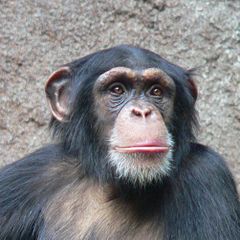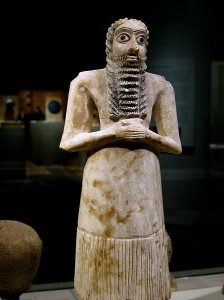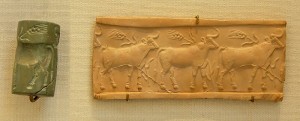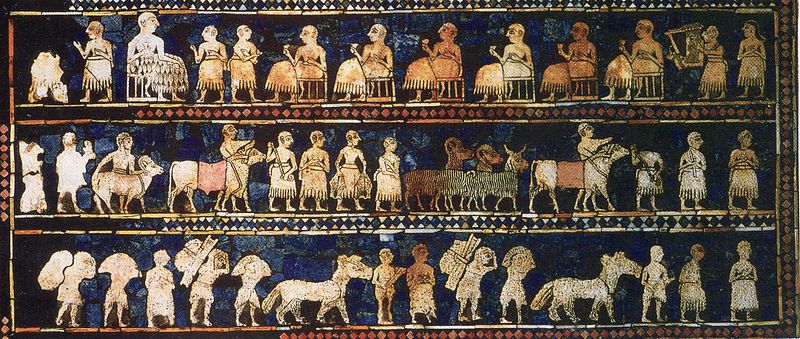
Ipnops
April 25, 2014

http://media.eol.org/content/2009/05/19/16/68617_orig.jpg (Photo R. B. Reyes) Ipnops Agassizii
http://upload.wikimedia.org/wikipedia/commons/thumb/1/17/Ipnops.JPG/640px-Ipnops.JPG Ipnops Murrayi
Human and Animal Vision
April 18, 2014 It turns out that humans are highly anthropocentric in how we conceive of vision. The measures that we use tend to be areas where problems in human vision arise: focusing at distant and close range, seeing at night, depth perception, field of vision, and colorblindness. We don’t factor in things that most humans can do easily, such as recognize patterns, and we also don’t think about things we can’t do at all, such as recognize the source of diffuse light.Here is a list of factors that vision entails (which may not be complete):
It turns out that humans are highly anthropocentric in how we conceive of vision. The measures that we use tend to be areas where problems in human vision arise: focusing at distant and close range, seeing at night, depth perception, field of vision, and colorblindness. We don’t factor in things that most humans can do easily, such as recognize patterns, and we also don’t think about things we can’t do at all, such as recognize the source of diffuse light.Here is a list of factors that vision entails (which may not be complete):
Ability to detect light (this is the core function of vision)Ability to locate the source of diffuse light (polarization)Ability to see in low lightAbility to see in bright lightSensitivity to changes in contrastAbility to see colorsRange of color visionAbility to distinguish hues within a narrow band of colorDepth perceptionDetection of movementAbility to see stationary objectsField of vision (including ability to see up and down as well as on a 360 degree plane)Focusing ability (including speed of focus on near and far objects)Ability to detect images at great distancesClarity of vision at far and close range (accommodation)Ability to detect shapes, both solid and outlineAbility to recognize patternsRapidity of image formation (analogous to frames per second in a camera)Clarity of underwater visionAbility to detect images below the surface of the water from above (and vice versa)Ability to compensate for idiosyncrasies in refraction (closely related to the factor above)Ability to compensate for movement (self locomotion as well as movement in the environment)Formation of a single image versus split visionCapacity for visual organs to withstand environmental challenges such as cold, pressure, and debris
I have not been able to find information comparing abilities to see and interpret auras.  So which animal has the best vision? I was a few chapters into this book before I realized what a silly question this is. Each animal has a type of vision perfectly adapted to its environmental niche. No eye or set of eyes can function in all areas extraordinarily well, because there are a few areas that are mutually exclusive and so it’s a choice between specialization or compromise. If I did have to pick the animal with the best vision, however, it would be any member of the ape family, including humans. No doubt many will not believe me and will dismiss this as more anthropocentricism. I say this because while there are animals who outperform us in every area of vision, except perhaps pattern recognition, our eyes function competently in a wide range of environments and circumstances. Our eyes do little that is spectacular but almost everything well. This is probably the main reason we have adapted to so many environments around the globe.SourceSinclair, Sandra. How Animals See: Other Visions of Our World. New York: Facts on File, 1985.Photo credits: Eagle–Vtornet; Chimpanzee–Thomas Lersch
So which animal has the best vision? I was a few chapters into this book before I realized what a silly question this is. Each animal has a type of vision perfectly adapted to its environmental niche. No eye or set of eyes can function in all areas extraordinarily well, because there are a few areas that are mutually exclusive and so it’s a choice between specialization or compromise. If I did have to pick the animal with the best vision, however, it would be any member of the ape family, including humans. No doubt many will not believe me and will dismiss this as more anthropocentricism. I say this because while there are animals who outperform us in every area of vision, except perhaps pattern recognition, our eyes function competently in a wide range of environments and circumstances. Our eyes do little that is spectacular but almost everything well. This is probably the main reason we have adapted to so many environments around the globe.SourceSinclair, Sandra. How Animals See: Other Visions of Our World. New York: Facts on File, 1985.Photo credits: Eagle–Vtornet; Chimpanzee–Thomas Lersch
How Animals See
April 11, 2014 Most of us intuitively understand that other animals do not see the world the way we humans do, and we like to imagine how things look from their point of view. It turns out that the ways of seeing are more intricate and varied than we realize.I am returning this week to a favorite topic of mine: vision. Over the next several weeks I will be sharing insights gleaned from my perusal of an out-of-print book, How Animals See: Other Visions of Our World, by Sandra Sinclair. This book examines eyesight in a wide range of creatures, from insects to mammals, sea dwellers to migrating birds.I did not realize when I picked up this book how unique it is, really one-of-a-kind. Since it was published in 1985 the other books on the subject have been children’s books, which is par for the course. Books on the really interesting topics seem to be written for kids, not grownups. Lack of interest may not be the primary factor here, however. The subject matter is difficult, so much so that biologists and others who study in this area use words and concepts that most people have only a fuzzy understanding of. Sinclair spent years researching her material under the mentorship of Dr. Dean Yeager of The State University of New York College of Optometry, and Dr. Yaeger writes in his foreword that even he was forced to read outside his areas of expertise in order to assist with the project. This seems to be the kind of book that only a very bright journalist with generous assistance from experts could make comprehensible to the lay reader. Even so, I do not think I would have been able to understand this material had I not already read some basic books about human eyesight such as Relearning to See by Thomas Quackenbush, which I wrote about last year.I have tried unsuccessfully to find a more up to date version of Sinclair’s work. I have found only two books that are close: a 2012 book called How Animals See the World: Comparative Behavior, Biology, and Evolution of Vision by Olga F. Lazareva et al and Animal Eyes by Michael F. Land and Dan-Eric Nilsson. The blurb at Goodreads boasts that How Animals See the World “…contains 26 chapters written by world-leading experts” and calls it “An exhaustive work in range and depth, … a valuable resource for advanced students and researchers in areas of cognitive psychology, perception and cognitive neuroscience, as well as researchers in the visual sciences.” Animal Eyes is billed by the publisher as “…a comparative account of all known types of eye in the animal kingdom, outlining their structure and function with an emphasis on the nature of the optical systems and the physical principles involved in image formation.” Both rather dense sounding texts assume a solid knowledge base in the visual sciences, which makes me appreciate Sinclair’s work all the more. I have to say, however, that I found even this book a stretch.Over the next few months, look forward to juicy bits of trivia about some very weird ways of seeing.SourceSinclair, Sandra. How Anmals See: Other Visions of Our World. New York: Facts on File, 1985.
Most of us intuitively understand that other animals do not see the world the way we humans do, and we like to imagine how things look from their point of view. It turns out that the ways of seeing are more intricate and varied than we realize.I am returning this week to a favorite topic of mine: vision. Over the next several weeks I will be sharing insights gleaned from my perusal of an out-of-print book, How Animals See: Other Visions of Our World, by Sandra Sinclair. This book examines eyesight in a wide range of creatures, from insects to mammals, sea dwellers to migrating birds.I did not realize when I picked up this book how unique it is, really one-of-a-kind. Since it was published in 1985 the other books on the subject have been children’s books, which is par for the course. Books on the really interesting topics seem to be written for kids, not grownups. Lack of interest may not be the primary factor here, however. The subject matter is difficult, so much so that biologists and others who study in this area use words and concepts that most people have only a fuzzy understanding of. Sinclair spent years researching her material under the mentorship of Dr. Dean Yeager of The State University of New York College of Optometry, and Dr. Yaeger writes in his foreword that even he was forced to read outside his areas of expertise in order to assist with the project. This seems to be the kind of book that only a very bright journalist with generous assistance from experts could make comprehensible to the lay reader. Even so, I do not think I would have been able to understand this material had I not already read some basic books about human eyesight such as Relearning to See by Thomas Quackenbush, which I wrote about last year.I have tried unsuccessfully to find a more up to date version of Sinclair’s work. I have found only two books that are close: a 2012 book called How Animals See the World: Comparative Behavior, Biology, and Evolution of Vision by Olga F. Lazareva et al and Animal Eyes by Michael F. Land and Dan-Eric Nilsson. The blurb at Goodreads boasts that How Animals See the World “…contains 26 chapters written by world-leading experts” and calls it “An exhaustive work in range and depth, … a valuable resource for advanced students and researchers in areas of cognitive psychology, perception and cognitive neuroscience, as well as researchers in the visual sciences.” Animal Eyes is billed by the publisher as “…a comparative account of all known types of eye in the animal kingdom, outlining their structure and function with an emphasis on the nature of the optical systems and the physical principles involved in image formation.” Both rather dense sounding texts assume a solid knowledge base in the visual sciences, which makes me appreciate Sinclair’s work all the more. I have to say, however, that I found even this book a stretch.Over the next few months, look forward to juicy bits of trivia about some very weird ways of seeing.SourceSinclair, Sandra. How Anmals See: Other Visions of Our World. New York: Facts on File, 1985.
Tasting Life to Its Fullest: My Love Affair with Mesopotamian Culture
April 4, 2014
In writing this book I did not intend to provide an exhaustive, scholarly study of eating and drinking among our venerable ancestors from ancient Mesopotamia. Such a work would have been tedious and dry, addressed (at the expense of honest readers) only to academics, who scarcely need it and may not want it.
I am not an academic or a scholar, so I appreciate that attention was paid to making the study of Mesopotamian cuisine interesting. I have, however, read a fair amount about the Sumerians and Akkadians, more than the average Pagan, so I also have some general context in which to place this cornucopia of information about food. One thing that jelled for me in exploring this book, which had only vaguely registered before, was an appreciation for the enthusiasm with which the ancient Mesopotamians approached the business of life. This can be glimpsed in their descriptions of their games, in the homage paid in word and picture to lovemaking, and in the exuberance with which the hero Gilgamesh throws himself into adventure, friendship, and even sorrow. Yet it was only in studying the art and excess of their food and drink that I came to recognize the Mesopotamian commitment to enjoying life. This was not merely the hedonism of “eat, drink, and be merry,” although sensuality certainly played a part. Mesopotamians worked as hard as they played, and they took significant pride in their accomplishments. They also loved hard: they loved their cities, their craftsmanship, their civilization, and the gods who rewarded them so generously for their labors. Their joie de vivre was not tempered by cynicism, as it so often is today, although they had a fine appreciation for ironic humor. If in the ancient world the Egyptians strove to be memorable, the Israelites to be good, the Greeks to be wise, the Romans to be victorious, the Celts to be honorable, and the Germans to be brave, the Mesopotamians strove to extract the most satisfying enjoyment possible out of life.In closing let’s turn once again to the words of the tavern keeper, sometimes identified as the goddess Ninkasi, to Gilgamesh
Humans are born, they live, then they die,this is the order that the gods have decreed.But until the end comes, enjoy your life,spend it in happiness, not despair.Savor your food, make each of your daysa delight, bathe and anoint yourself,wear bright clothes that are sparkling clean,let music and dancing fill your house,love the child who holds you by the hand,and give your wife pleasure in your embrace.That is the best way for a man to live.
SourcesBottero, Jean. The Oldest Cuisine in the World: Cooking in Mesopotamia. Translated by Teresa Lavender Fagan. Chicago: University of Chicago Press, 2004.Mitchell, Stephen. Gilgamesh: A New English Version. New York: Free Press, 2004.
Food for the Gods
March 28, 2014
Biblical sacrifice, the idea of which we have become more or less accustomed to, is basically a negative gesture: it deprives us – and we willingly accept this deprivation – of something we reserve for God without his having a need or use for it. In Mesopotamia, on the other hand, sacrifice, offerings to the gods, were positive actions: what was given to them, they needed.
 In order to understand the role of food in religious life, it is also necessary to move out of contemporary constructs about food. We think of food as fuel or sustenance, we think of food as sensory enjoyment, we think of certain foods as symbolic, and we think of shared food as a means of social cohesion. For Mesopotamians food was all of these things, but it was something more. Food was imbued with certain powers, particularly the power of life. The various prayers and ceremonies involved in the harvesting, milling, butchering, and preparing of food enhanced these powers and added new ones. Recall that when Inanna is trapped in the underworld unable to save herself, the god Enki sends his representatives down to revive her with the “bread of life” and “water of life.” Recall also from the previous post that Ereshkigal participated in an important ceremony not by being present but by partaking in the food that was served. Throughout Sumerian and Akkadian myth the idea is implied but not specifically spelled out that food is a means of disseminating power.Millers, farmers, herders, and others donated the basic ingredients to meet the voracious appetites of the gods. There were specifications about how animals destined for the temple should be raised and fed. All of the meat was high quality and some of it was exceptional. Special prayers were spoken when butchering temple animals or when milling grain that would be used for temple bread. Though high quality ingredients were used in food preparation, and meals were served on the finest platters and vessels by priests or priestesses dressed in immaculate clothing, the recipes themselves were basic. Meat was grilled or boiled rather than simmered in the elaborate sauces that characterized Mesopotamian cooking from the empire stage onward, at least for people with means. The gods were believed to be traditionalists in their culinary tastes, preferring food as it was prepared in prehistory.What finally became of all that food? The accounting involved in meeting the meal specifications for the gods must have been daunting in itself. In fact, we have learned much about the feeding of the gods by making inferences from temple accounting records, which are extensive. The food could not have been left outside the city once the gods had gorged themselves without creating a huge problem with lions, hyenas, and other scavengers. Nor could this much food have been consumed by the what must have been a large temple staff. Though Mesopotamian cultures in historic times, and even in the archaeological records of prehistory, were highly class stratified, this food would not have been destined for the tables of aristocrats. As mentioned a few posts back, rich men employed an extensive kitchen staff to prepare elaborate meals catering to their sophisticated tastes. They would not have eaten such simple food except when participating in religious rites. Unfortunately the temple accountants did not see a need to document how the food was disbursed once the gods had eaten their share. Probably it was given away.SourceBottero, Jean. The Oldest Cuisine in the World: Cooking in Mesopotamia. Chicago: University of Chicago Press, 2004.
In order to understand the role of food in religious life, it is also necessary to move out of contemporary constructs about food. We think of food as fuel or sustenance, we think of food as sensory enjoyment, we think of certain foods as symbolic, and we think of shared food as a means of social cohesion. For Mesopotamians food was all of these things, but it was something more. Food was imbued with certain powers, particularly the power of life. The various prayers and ceremonies involved in the harvesting, milling, butchering, and preparing of food enhanced these powers and added new ones. Recall that when Inanna is trapped in the underworld unable to save herself, the god Enki sends his representatives down to revive her with the “bread of life” and “water of life.” Recall also from the previous post that Ereshkigal participated in an important ceremony not by being present but by partaking in the food that was served. Throughout Sumerian and Akkadian myth the idea is implied but not specifically spelled out that food is a means of disseminating power.Millers, farmers, herders, and others donated the basic ingredients to meet the voracious appetites of the gods. There were specifications about how animals destined for the temple should be raised and fed. All of the meat was high quality and some of it was exceptional. Special prayers were spoken when butchering temple animals or when milling grain that would be used for temple bread. Though high quality ingredients were used in food preparation, and meals were served on the finest platters and vessels by priests or priestesses dressed in immaculate clothing, the recipes themselves were basic. Meat was grilled or boiled rather than simmered in the elaborate sauces that characterized Mesopotamian cooking from the empire stage onward, at least for people with means. The gods were believed to be traditionalists in their culinary tastes, preferring food as it was prepared in prehistory.What finally became of all that food? The accounting involved in meeting the meal specifications for the gods must have been daunting in itself. In fact, we have learned much about the feeding of the gods by making inferences from temple accounting records, which are extensive. The food could not have been left outside the city once the gods had gorged themselves without creating a huge problem with lions, hyenas, and other scavengers. Nor could this much food have been consumed by the what must have been a large temple staff. Though Mesopotamian cultures in historic times, and even in the archaeological records of prehistory, were highly class stratified, this food would not have been destined for the tables of aristocrats. As mentioned a few posts back, rich men employed an extensive kitchen staff to prepare elaborate meals catering to their sophisticated tastes. They would not have eaten such simple food except when participating in religious rites. Unfortunately the temple accountants did not see a need to document how the food was disbursed once the gods had eaten their share. Probably it was given away.SourceBottero, Jean. The Oldest Cuisine in the World: Cooking in Mesopotamia. Chicago: University of Chicago Press, 2004.
Feasting with the Dead
March 21, 2014
Following a Pagan Path
March 14, 2014 Review: Starcat’s Corner: Essays on Pagan Livingby N. Starcat ShieldsMoon Books, 2013.A friend called me on the phone awhile back, excited about some people she had met on an airplane. “They had a little girl who was named – what’s the name of your cat again?”“Samhain?” I said.“Yeah that’s right, Samhain. They had a two-year-old girl who was named the same name as your cat. I never heard that word in my life before I met your cat, and now I’m hearing it a second time.”“Oh, so those people were witches,” I said.“What do you mean, witches?”“You know, witches. You’ve been to ritual with me and you know what a witch is. Samhain is Irish for Halloween, and who’s going to name their kid Halloween besides a witch?”“But no, they couldn’t have been witches,” she replied. “These were normal people.”So I guess I’m not “normal people,” I thought to myself. Leaving aside that troublesome revelation, this conversation illustrates the preconceptions people continue to hold about witches, even people who understand that we are followers of an Earth-based religion, and we don’t worship the devil, and we fly around on airplanes, not brooms. Witches are still surrounded by an aura of differentness, considered more foreign than an inhabitant of the most secluded village on Earth, unless that villager also happens to be a witch. We can be glamorous, or spooky, or impenetrable, but at any rate we are not normal.These stereotypes are silly. A witch has far more in common with her fellow Earth citizens than most people imagine. This is beautifully illustrated in N. Starcat Shields’ book Starcat’s Corner: Essays on Pagan Living. In this collection of short essays spanning ten years we follow Starcat as she confronts the challenges of living, some of which are endemic to American life at the turn of the millennium and others which are timeless. She struggles with being a parent, reacting to a natural disaster, hanging out at the hospital while a loved one receives critical medical care. She searches for meaningful employment, makes important financial decisions, visits the chiropractor, and accepts the loss of a beloved animal companion. Her perspective on all of these things is very different from that of a Methodist or a Mormon, not to mention that of an atheist, but she successfully weathers the crises, complexities and banalities of living with decision-making processes that most would consider unconventional.Starcat says that the genesis of these essays was a question that was posed at Vermont Witch Camp: “How do you live your earth-based spirituality, day in and day out, particularly in a culture that doesn’t share your values?” While the question became the premise for an interesting book, I have to say that I don’t think much of the question itself. To me it evokes too much of the politically correct smugness I have noted in some Pagan circles: the idea that we are the good people with the high values surrounded by a sea of the unenlightened who don’t share those values. If you’ve spent a lot of time in different Pagan communities, you know what I’m talking about.“How could witches be judgmental?” my friend who doesn’t think witches can be normal asks me incredulously. The implication behind the question is that as people near the bottom of the scorn pile, perhaps only a step above criminals, we witches should know better. I could provide a list of reading material showing that in this respect, as well as in any other, witches are completely normal.But Starcat’s Corner is not like that, as she reveals herself to be more interested in helping people than judging them. She is the kind of witch we all want to be. I’ll close this review with a short excerpt from Starcat’s Corner:
Review: Starcat’s Corner: Essays on Pagan Livingby N. Starcat ShieldsMoon Books, 2013.A friend called me on the phone awhile back, excited about some people she had met on an airplane. “They had a little girl who was named – what’s the name of your cat again?”“Samhain?” I said.“Yeah that’s right, Samhain. They had a two-year-old girl who was named the same name as your cat. I never heard that word in my life before I met your cat, and now I’m hearing it a second time.”“Oh, so those people were witches,” I said.“What do you mean, witches?”“You know, witches. You’ve been to ritual with me and you know what a witch is. Samhain is Irish for Halloween, and who’s going to name their kid Halloween besides a witch?”“But no, they couldn’t have been witches,” she replied. “These were normal people.”So I guess I’m not “normal people,” I thought to myself. Leaving aside that troublesome revelation, this conversation illustrates the preconceptions people continue to hold about witches, even people who understand that we are followers of an Earth-based religion, and we don’t worship the devil, and we fly around on airplanes, not brooms. Witches are still surrounded by an aura of differentness, considered more foreign than an inhabitant of the most secluded village on Earth, unless that villager also happens to be a witch. We can be glamorous, or spooky, or impenetrable, but at any rate we are not normal.These stereotypes are silly. A witch has far more in common with her fellow Earth citizens than most people imagine. This is beautifully illustrated in N. Starcat Shields’ book Starcat’s Corner: Essays on Pagan Living. In this collection of short essays spanning ten years we follow Starcat as she confronts the challenges of living, some of which are endemic to American life at the turn of the millennium and others which are timeless. She struggles with being a parent, reacting to a natural disaster, hanging out at the hospital while a loved one receives critical medical care. She searches for meaningful employment, makes important financial decisions, visits the chiropractor, and accepts the loss of a beloved animal companion. Her perspective on all of these things is very different from that of a Methodist or a Mormon, not to mention that of an atheist, but she successfully weathers the crises, complexities and banalities of living with decision-making processes that most would consider unconventional.Starcat says that the genesis of these essays was a question that was posed at Vermont Witch Camp: “How do you live your earth-based spirituality, day in and day out, particularly in a culture that doesn’t share your values?” While the question became the premise for an interesting book, I have to say that I don’t think much of the question itself. To me it evokes too much of the politically correct smugness I have noted in some Pagan circles: the idea that we are the good people with the high values surrounded by a sea of the unenlightened who don’t share those values. If you’ve spent a lot of time in different Pagan communities, you know what I’m talking about.“How could witches be judgmental?” my friend who doesn’t think witches can be normal asks me incredulously. The implication behind the question is that as people near the bottom of the scorn pile, perhaps only a step above criminals, we witches should know better. I could provide a list of reading material showing that in this respect, as well as in any other, witches are completely normal.But Starcat’s Corner is not like that, as she reveals herself to be more interested in helping people than judging them. She is the kind of witch we all want to be. I’ll close this review with a short excerpt from Starcat’s Corner:
The negative, or shadow side, of seeking is that we may become perpetual students. Either we absorb some of the teachings and then move on, never content to delve deeply into a particular source of wisdom, or perhaps we continue to study one area so intently that our life becomes imbalanced. We are so focused on the seeking itself that we never allow ourselves to come to any conclusions about what we believe. In order to avoid being stuck in this mode, you might devote yourself to a particular set of teachings for a year and a day. If you are studying on your own, write an article or research paper that encompasses what you’ve been learning. These actions will help you shift from a mode of constant movement and passive receiving into a place of more depth and active sharing.The positive part of seeking is the innocence of the beginner’s mind. In yoga, we are encouraged to approach each pose, or asana, as if it is the first time we have practiced it. This keeps the mind on the present moment. If we are truly seeking and open to finding wisdom, we are never jaded or cynical. We are able to take in that which we see, fully and with an open mind and heart.
The Emerald Tablet of Hermes
March 7, 2014 Isaac Newton is considered one of the greatest minds of the Enlightenment and the founder of modern physics. Along with Gottfried Wilhelm Leibniz, he set the foundations for calculus. He is best known for his observations on how gravity behaves, the so-called laws of gravity. As Professor Richard Wolfson of Middlebury College emphatically put it during a lecture on modern physics, Newton stated for the very first time that the laws on earth are the same for the rest of the universe.I don’t want to diminish Newton’s standing as one of the greatest contributors to math and physics, but listening to this lecture I couldn’t help but think how wrong is the assumption that Newton was the first to run across this principle. This is a very old metaphysical concept, implicit in the literature of the Akkadians and found among the ancient Greeks as well. It is explicitly set out as a cornerstone of alchemical philosophy in “The Emerald Tablet of Hermes,” probably written in the eighth century and attributed to earlier Egyptian sources. This is the teaching that starts out That which is above is as that which is below, and that which is below is as that which is above, for performing the miracles of the one thing.Listening to Professor Wolfson attribute to Newton not only the foundation of calculus and physics but the core of alchemy, I felt inspired to look up the Tablet of Hermes and read it again. So I went to Sacred Texts, where as expected I found several translations. Imagine my amusement at finding one of the earliest English translations to have been done by Newton! This translation is dated 1680, and Newton published his famous physics treatise in 1687. Obviously, Newton’s genius lies in formulating the ancient truths in a scientific and mathematical framework. Here is Newton’s translation of the Hermes tablet:
Isaac Newton is considered one of the greatest minds of the Enlightenment and the founder of modern physics. Along with Gottfried Wilhelm Leibniz, he set the foundations for calculus. He is best known for his observations on how gravity behaves, the so-called laws of gravity. As Professor Richard Wolfson of Middlebury College emphatically put it during a lecture on modern physics, Newton stated for the very first time that the laws on earth are the same for the rest of the universe.I don’t want to diminish Newton’s standing as one of the greatest contributors to math and physics, but listening to this lecture I couldn’t help but think how wrong is the assumption that Newton was the first to run across this principle. This is a very old metaphysical concept, implicit in the literature of the Akkadians and found among the ancient Greeks as well. It is explicitly set out as a cornerstone of alchemical philosophy in “The Emerald Tablet of Hermes,” probably written in the eighth century and attributed to earlier Egyptian sources. This is the teaching that starts out That which is above is as that which is below, and that which is below is as that which is above, for performing the miracles of the one thing.Listening to Professor Wolfson attribute to Newton not only the foundation of calculus and physics but the core of alchemy, I felt inspired to look up the Tablet of Hermes and read it again. So I went to Sacred Texts, where as expected I found several translations. Imagine my amusement at finding one of the earliest English translations to have been done by Newton! This translation is dated 1680, and Newton published his famous physics treatise in 1687. Obviously, Newton’s genius lies in formulating the ancient truths in a scientific and mathematical framework. Here is Newton’s translation of the Hermes tablet:
Tis true without lying, certain & most true.That wch is below is like that wch is above & that wch is above is like yt wch is below to do ye miracles of one only thing.And as all things have been & arose from one by ye mediation of one: so all things have their birth from this one thing by adaptation.The Sun is its father, the moon its mother,the wind hath carried it in its belly, the earth its nourse.The father of all perfection in ye whole world is here.Its force or power is entire if it be converted into earth.Seperate thou ye earth from ye fire, ye subtile from the gross sweetly wth great indoustry.It ascends from ye earth to ye heaven & again it desends to ye earth and receives ye force of things superior & inferior.By this means you shall have ye glory of ye whole world & thereby all obscurity shall fly from you.Its force is above all force. ffor it vanquishes every subtile thing & penetrates every solid thing.So was ye world created.From this are & do come admirable adaptaions whereof ye means (Or process) is here in this.Hence I am called Hermes Trismegist, having the three parts of ye philosophy of ye whole world.That wch I have said of ye operation of ye Sun is accomplished & ended.
Footnote: Here’s another article I found while preparing this one, which talks about the scientific community’s uneasiness with the metaphysical influences on Newton’s work, observing “Newton’s alchemy is a bit of an embarrassment to modern scholars.”
